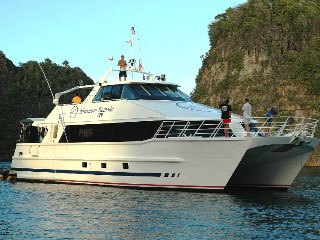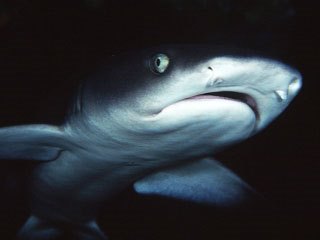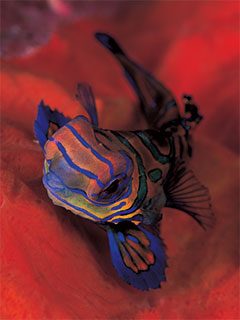"Over 19 years making dreams come true for divers... just like you"
Contact us now at ask@dive-the-world.com
Komodo Liveaboard Diving Trip Report
My Dive Adventure in Komodo, Flores and Alor
As the scuba world is beginning to realise, there are few more incredible diving destinations than the Nusa Tenggara and West Papua regions of Indonesia. New discoveries are regularly being made in this rich marine habitat, the world's epicenter of marine biodiversity. As if custom-made for an awesome liveaboard adventure, the region is a vast ocean playground, peppered with innumerable islands.
The reefs in this area are not all 100% intact, but because of the inaccessibility of so many of the dive spots, there are countless pristine reefs undamaged by human activity, a feature that is increasingly rare in today's world. There are not many liveaboards that operate here, considering the vastness of the region, but I was lucky enough to join the MV Adventure Komodo in November 2005 for an unforgettable voyage of pioneer diving. The boat no longer operates here but is a 23 metre catamaran, designed for comfort and not a little speed, cruising at 15 knots.
Introducing Larry

The trip I joined was a 2 week transit liveaboard cruise from Bali to Kupang in West Timor, a huge distance made manageable by the comfort of the vessel. As I was settling into the cabin there was a knock on the door as the chef asked me how I would like my steak done. "Ahh, this is the life I deserve" I thought as I excitedly unpacked my belongings. That was the start of things to come as the high level of gastronomy and service continued throughout the vacation.
The first evening's dinner saw all the guests getting to know each other over the great food and the conversation flowed along with the complimentary wine, sourced from the owner's award-winning winery in Australia.
Larry Smith was our cruise director. He is a man, who for many, needs no introduction. Google him to see his many achievements in the world of diving and marine conservation. Sadly he has now passed away and I won't forget the 2 weeks I had in his warm and entertaining presence. He was a large Texan for whom the word charisma could have been invented, and is credited with discovering a considerable amount of Indonesia's finest muck diving, beginning in the now world-famous Lembeh Strait. He seemed to be a bottomless pit of stories. Often these experienced types can be incredible bores, listing their achievements and seeking to define themselves as dive gods. However, Larry managed to talk for 2 weeks with a blend of humour and humility that made listening to him a pleasure. He also managed to constantly put the welfare of the guests at the top of his agenda, making him the perfect liveaboard host.
We cruised to Sumbawa on our first night aboard, waking up to the breathtaking view of Satonda Island, one of many beautiful vistas we would enjoy on the trip. Here we took in the sight of Mount Tombora, a volcano which in 1815 erupted with massive force (20 times that of Krakatoa). The eruption took the lives of more than 28,000 people and even caused a year long alteration to the earth's climate. Even when cruising along, we were able to watch the changing scenery through the large wrap-around windows of the saloon which provided 270 degrees of view.
We enjoyed 4 dives around Satonda and visited the sacred lake in the centre of the island. In accordance with local legend we cleansed ourselves in the lake (supposedly inhabited by a giant sea serpent) and tied a stone to a sacred tree for luck, before returning to the liveaboard boat to make our way north west to the Komodo diving region.
Komodo

On arrival, we explored Menjang Wall and the Black Forest not far from Sangeang Island, an area famed for its sometimes ripping currents. This area where the South China Sea meets the Indian Ocean sometimes sees huge volumes of water rushing through. In the absence of strong current there was less chance of seeing manta rays and large pelagics, but in the placid conditions we were able to enjoy the beautiful soft corals as well as some critters, such as harlequin shrimps and demon stingers.
The next day saw us at GPS Point, a submerged pinnacle just off Banta Island, which is one of Komodo's best known dive sites, and here the currents really picked up. Larry briefed us fully about the conditions to expect and to follow our guides closely due to the likelihood of some strong down currents. We all heeded his advice and were rewarded with an excellent dive.
Fish life here was abundant with schools of sweetlips, surgeonfish and fusiliers all over the place. Giant trevallies hunted further off the reef and white-tip reef sharks glided around the deeper sections. On our safety stop we clung to the rocks, buffeted by the current as a hawksbill turtle cruised nonchalantly past.
I was desperately keen to see some manta rays as I have often read that they are regularly sighted in this region. So you can imagine my excitement when I was awoken on day 5 to hear excited chattering about 5 mantas swimming around the boat. Within seconds I was out of bed and easing myself into the water with mask and fins on. I have been lucky enough to encounter mantas on many occasions, but perhaps because of being recently asleep and due to the graceful way they swooped and seemed to play around us, this was a special encounter. There can be no better way to start any day.
I had heard some people say that Indonesia has been vastly over-fished and that many of the bigger species had all but disappeared, so seeing this group of mantas was especially pleasing. Over-fishing is still a problem in many parts of Indonesia. However, my experience was that there are still plenty of big pelagics and large reef fish here. On Ikelike Reef an enormous school of bumphead parrotfish cruised past us. Sharks and giant trevallies were around at both Crystal Bommie and Pink Beach, the latter also providing an unusual encounter with a coral cat shark.
Day 6 saw us venture onto the fabled land of Komodo Island. "Here be dragons" warned sailors' maps in days of yore, so it was quite a thrill to finally be here. Komodo is a UNESCO World Heritage Site and it is home to around 2,000 Komodo dragons, known scientifically as Varanus Komodoensis. These beasts can exceed 2.5 metres in length and weigh up to 125 kilos, unsurprisingly making them the world's largest lizard. We went for an 8 km walking tour with a park ranger into the island to try to spot them in their natural habitat, since many gather around the ranger station near the shore. We spotted 1 or 2 juveniles but it seems most of the big boys hang out where the easy meals are to be had i.e. the ranger station. Some of the guests bought pearls, carved dragons and other trinkets in the knowledge that there is a touch of mystique in saying to their loved ones back home "I bought you this from Komodo".
Horseshoe Bay
Back on board we cruised into Horseshoe Bay on the south of the island of Rinca, which was enjoying a period of lush green growth in stark contrast to the barren brownness of Komodo. The tropical downpour that followed right on top of us left us in no doubt as to the source of the greenness.
For the next 3 nights we stayed in Horseshoe Bay. Every night we could dine in the saloon and be entertained by the action on the beach only 50 metres away. The beach was a hive of activity with eagles, wild pigs, dragons and monkeys scavenging for food. To my delight we were the only dive boat around, which is surely one of best features of liveaboard diving in Indonesia. Apart from the occasional outrigger that would come into the bay it was just us, the animals on the beach and the dolphins that would appear around the boat in the morning. One morning I held on to a rope that was fed out behind the tender so that I could be towed along slowly. Breathing through a snorkel, I could watch the dolphins below and they swam and frolicked and looked up at what must have been a curious sight for them, namely me grinning like a sack of spanners. Interacting with dolphins is indescribably special and totally unforgettable.
Underwater was just as much fun as above the surface. I saw 2 pygmy seahorses, one of which was a heavily pregnant male at the Yellow Wall of Texas, sometimes called Larry's Yellow Wall of Texas (after guess who?). I loved the spectacular wall of colourful corals and crinoids at the site called Crinoid Canyon at Nusa Kode. There was also enough marine life to keep even the most jaded scuba diver happy including clown triggerfish, longnose hawkfish and giant groupers. However it was a tad chilly here so I was glad I was in a full length 5 mm with a hood. I also spent much too long luxuriating in the hot showers after diving.
Cannibal Rock also had sights to please every diver, from turtles to white tip reef sharks, zebra crabs to giant frogfish. The endemic sea apples also added a fascinating splash of bright red and purple. 3 torpedo rays were spotted on 1 dive as well as a crocodile fish, sea horse, candy crab and a pink frogfish.
• Watch our Komodo diving video
Flores Island

After another night of cruising we arrived in Flores on Day 9. Our first dive near Maumere was on a Japanese freighter wreck called the Wai Terang, and was followed by 2 dives under the piers of Maumere harbour. Here while finning around the concrete pillars and bits of tangled metal, we spotted innumerable critters making these dives both unusual and incredibly satisfying. The place was crawling with stinging catfish, leaf fish and frogfish to name but a few.
Pegasus sea moths and mandarinfish also chose to make this bizarre seascape their home. The beauty of scuba diving in Flores is that new discoveries are being made all the time, including a new species of mandarinfish discovered by Edi Frommenweiler of the MY Pindito.
North Flores offered other excellent dives such as Patah Batang, where there were a couple of eagle rays, lots of whitetips, parrotfish and sweetlips to view as we were carried along by the gentle but steady current. We also saw the unusual sight of 2 ribbon eels sharing the same sandy burrow.
On Day 12 we were told we could choose between the known (a dive site called Magic Log) and the unknown (a new area around Andonara Island). Half of us yelled "Let's explore" and so we did. On our descent we saw a school of chevron barracuda, auguring well for the rest of the dive. Our excellent guide Ali discovered a weedy scorpionfish (Rhynopia) sitting next to some encrusted sponge within seconds of reaching the patchy coral floor. We had been discussing the very same creature on the boat the night before and for some it was Number One on their wish list. Cue lots of underwater high fives and flashes of cameras!
So good was that morning dive that over breakfast we resolved to go again and show the other half of the guests the Rhynopia.
Andonara translates as brother's blood and in our guidebook we were a little perturbed to hear that it apparently had the most violent locals in Indonesia! However, our experience was one of a great welcome as the laughing children swarmed around us as soon as we landed on the jetty. The village is one of only 2 whaling communities in Flores, an industry that is dying out. We took lots of photographs and bought a few sarongs and trinkets before waving goodbye and setting sail for Lembata Island and the other whaling village of Lamalera.
Some chose to explore the island while others, including myself, opted to go diving. The result was the dive with possibly the greatest biomass of the whole trip. Sharks, angelfish and sweetlips were all present in big numbers and hundreds of rainbow runners darted past us several times.
Alor
Day 13, and we breakfasted near Bianganbang village, Pantar Island, Alor, where we could see steam rising from the hot springs and the village buzzing with the activity of market day. Twilight Zone was the first dive of the day and was a critter site which yielded yet more fantastic specimens, including a Pegasus sea moth, snake eels and mantis shrimps. Amazingly, in the time it took for our surface interval, the temperature of the water went from a balmy 27 to a little chilly 24°C. However no-one noticed the cold when we were watching the antics of a Mimic octopus on the second dive.
Lots of happy and excited children came on board at lunch time, and we gave them presents of little whistles which they accepted with more glee than the average western kid would do when given the latest Playstation.
The next dive was on a beautiful reef with pristine coral and plenty of wrasses and large groupers. While photographing a gorgeous yellow leaf fish on some table coral, I also noticed a harlequin ghost pipefish almost perfectly camouflaged. Back at the Twilight Zone for the night dive we saw 2 fabulous Spanish Dancers. Apart from in a downtown bar in the Costa Del Sol, I had never seen a Spanish Dancer before, so this was a highlight for me.
On the last day we had to bear in mind the flying after diving guidelines, so we did only 2 dives in the morning, which were also both very rewarding and it was sad to know as I surfaced from the second dive that the end was nigh.
Motoring back to Kupang, I went to rinse and sort out my equipment only to find it had already been thoroughly done by the crew. Stepping off the Adventure Komodo liveaboard, I knew that this had been an awesome trip in every sense. Great boat, entertaining company and amazing diving. The Adventure Komodo was heading up to Raja Ampat and there would soon be another group of lucky divers stepping aboard for that tour.
We all boarded the plane for our short flight from Kupang to Bali, and then went our separate ways. Waving goodbye to each other I knew that it wouldn't be long before I was back in Indonesia. Perhaps I'll do one of the Raja Ampat liveaboards next time!
Article written by Paul Flaxman, November 2005
CUSTOMER TESTIMONIALS OF DIVE THE WORLD
... The website is easy to navigate and I cannot think of anything that would have made it easier. Everything went smoothly - no complaints! Strengths include prompt responses, clear information, patience with answering many questions, easy payment ... -- Robin Waxman, USA. [More customer reviews]






